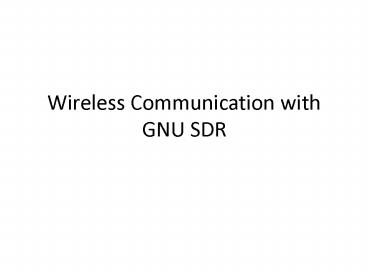Wireless Communication with GNU SDR - PowerPoint PPT Presentation
Title:
Wireless Communication with GNU SDR
Description:
Wireless Communication with GNU SDR A simplified wireless communication scheme GNU Software Defined Radio Basically, the idea is to generate the baseband waveform in ... – PowerPoint PPT presentation
Number of Views:47
Avg rating:3.0/5.0
Title: Wireless Communication with GNU SDR
1
Wireless Communication with GNU SDR
2
A simplified wireless communication scheme
3
GNU Software Defined Radio
- Basically, the idea is to generate the baseband
waveform in the computer and send it to the USRP.
- The USRP converts the digital waveform into
analog waveform and send it out. - The receiver does the reverse.
4
The code for a simple BPSK transmitter and
receiver
- http//www.cs.fsu.edu/zzhang/CIS5930_Spring_2009_
files/tea1.py - Basically, the signal processing functions are
implemented in C as signal processing
blocks. The blocks can be considered as
equivalent to hardware chips with inputs and
outputs, and a black box which process the inputs
into outputs. - The signal processing blocks are connected in
Python. - You will have a signal source and a signal sink.
5
The sender
- Signal Source. Basically a series of bytes
- self.bytes_src1 gr.vector_source_b(array1,
True) - Turn bytes into k-bit vectors
- self.bytes2chunks gr.packed_to_unpacked_bb(self.
bits_per_symbol(), gr.GR_MSB_FIRST) - Turn k-bits into symbols
- self.chunks2symbols gr.chunks_to_symbols_bc(psk.
constellation2)
6
The sender
- The low pass filter
- self.rrc_filter gr.interp_fir_filter_ccf(self._s
amples_per_symbol, self.rrc_taps) - Then send it to the signal sink. Thats it!
- fg.connect(self.bytes_src1, self.bytes2chunks,
self.chunks2symbols, self.rrc_filter, self.amp,
self.u) - For debugging, you can also connect the output of
any signal processing block to a file sink, and
play it
7
The Receiver
- First, there is signal source self.u (USRP)
- Then, pass it to amplifier, channel filter, then
to rrc_filter, then to the gr.mpsk_receiver_cc,
which turns the received baseband signal into
bits (its actually symbols that can be
immediately converted to bits) - self.receivergr.mpsk_receiver_cc(arity, 0,
-
self._costas_alpha, self._costas_beta, - fmin,
fmax, -
self._mu, self._gain_mu, - omega,
gain_omega, -
_def_omega_relative_limit)
8
The baseband waveform
- Check the linux machine
9
Complex representations
- You have to get used to representing the received
signal as complex numbers. - That is, r(t) Re(t) jIm(t).
- Why?
- Because if you will multiply the r(t) with both
cos(2\pi ft) and sin(2\pi ft), and both will be
sent to a LPF. The one corresponding to cos(2\pi
ft) is regarded as the real part and the one
corresponding to sin(2\pi ft) is regarded as the
imaginary part.
10
Complex representations
- Suppose the sender sends I(t)cos(2 \pi ft). It
can be considered as I(t)cos(2 \pi ft) 0 sin(2
\pi ft). - Suppose the phase difference between the sender
and the receiver is \phi. So, the receiver will
get I(t)cos(\phi) in one branch and
I(t)sin(\phi) in the other branch (you can verify
it). Its therefore natural to regard the two
signals as the real and the imaginary component
of signal I(t) ej\phi.
11
Frequency representation
- You must also get used to the frequency
representation of the time domain signal. - Time domain cos(2\pi ft). To specify it, you
have to specify its value at every time instant. - Frequency domain a cosine wave with frequency
f. Thats it. - They are basically different languages talking
about exactly the same thing.
12
Frequency
- As mentioned last time, the received signal can
be regarded as the summation of sine waves at
various frequencies. - F(w) \int_-\infty\infty f(t) e-jwt dt.
- f(t) \int_-\infty\infty F(w) ejwt dw.
- Example.
- f(t) cos(w_0 t). F(w) \infty (ww_0, -w_0),
and 0 in all other values. - http//www.analyzemath.com/trigonometry/trigonomet
ric_formulas.html

